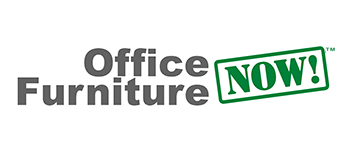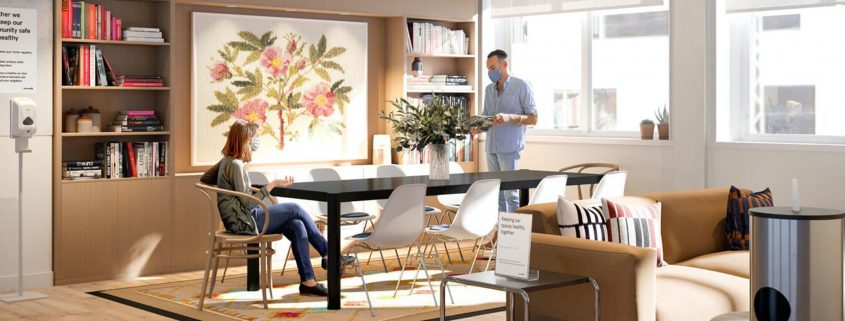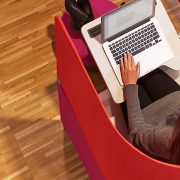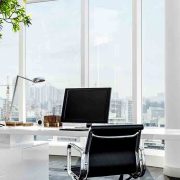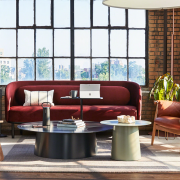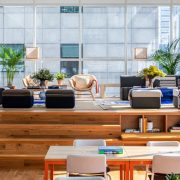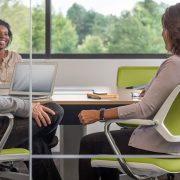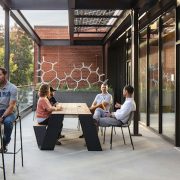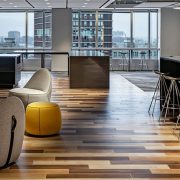Realigning The Future Of Work
The future of work begins with an increased awareness of how wellness influences wellbeing in the workplace. The planners setting policies and procedures will need to align what was endearing about working from home with their workplace culture to set the stage for the aesthetic of the future.
Creating the best of both worlds within your office design means designing a casual aesthetic that includes designated spaces for collaboration and culture building, juxtaposed with private areas for quiet focused work, while also having the agility to connect with remote workers when needed. What works best for your company will depend upon your culture and workflow. Creating an environment that’s all about connectivity is important for professional growth, collaboration, and company culture, as well as talent retention and future growth.
INNOVATION
Installing innovative LED video systems and communication equipment that will seamlessly connect both employees and clients will be one of the most important investments for the future of work. Multiple cameras in conference rooms and huddle spaces that will allow team members, both in-office and virtual, to be seen as well as heard.
Touchless technology exists for opening doors, hand washing, toilet flushing, and water dispensing are increasing in use. Touchless systems allow visitors to use a scanned QR code at an entry kiosk and gain access to an elevator and doorway. Hand sanitizer stations are readily available.
A safe efficient workplace should include anti-microbial materials and finishes to aid in reducing the transmission of viruses and bacteria. These “smart” materials are easy to maintain, resist mold, and promote good indoor air quality. With increased time on-screen, invest in eyeglass lenses that block blue light to reduce eye strain and damage.
Create a plan for large investments, such as ventilation through operable windows, improved air filtration, HVAC systems that bring in more outdoor air, and destination dispatch elevators will take time to adopt. More expensive technology takes longer to become commonplace, but like LEED adoption, new technologies will become more desirable.
INCLUSIVITY
Forward-thinking business owners will be contemplating design strategies that will accommodate the needs of all generations while maintaining their company’s core values.
Younger staff have adapted well to staying connected virtually even when working fully remote. Use these talents internally to implement mentoring and training opportunities with younger staff to assist older managers and employees who may struggle with establishing strong connections while working virtually. This type of cross-cultural exchange on how to utilize new technologies helps maintain an inclusive culture and raise productivity.
By focusing on high-touch communication strategies, developing flexible systems and policies, and building trust and respect, we are finding new avenues to reconnect and collaborate despite the uncertainty of the business climate post lockdown.
When bringing people back into the office, phase the process gradually. Throughout the process, communicate clearly and explain the decisions being made thoroughly to employees, encouraging open dialogue and constructive feedback.
WORKPLACE WELLNESS
Engaged wellbeing has become part of significant research for the workplace of the future. Long before the lockdown forced a rethink, corporations around the world had been experimenting with 4-day work weeks. The latest research confirms the that not only is a shorter workweek better for workers, it’s also better for businesses—including those in the public sector; it sets a strong precedent for public authorities and companies worldwide. And it reflected no loss in revenue.
A trial of a 4-day workweek found improved wellbeing, work-life balance, and collaboration among workers — and importantly, no loss of revenue for the organizations involved. Workers reported feeling better, more energized, and less stressed. Spending less time working accounts for an overall better attitude, and more energy to get non-work activities efficiently accomplished paving the way for fewer distractions at work.
Understandably, architects and designers are essential to workplace culture coming back together. They will provide viable strategies to create even safer living and working environments for the future. Safety has two facets: being safe and feeling safe. Technology is just one component, a well-planned design will provide the backbone structure and essential insights to ensure that clients and employees feel safe within the spaces we work.
Our team of space planners and designers are standing by to assist you with these challenges and the questions you may have about designing an agile office that meets your current and future needs.
Image from WeWork
 SPACE PLANNING & DESIGN SERVICES: Modern office design determines workflow by creating order and efficiency within the built environment. The role of design in the workplace is backed by significant research and development that evolves and changes frequently with trends. Contact us at 512-448-3769 or email, experts@officefurniturenow.com
SPACE PLANNING & DESIGN SERVICES: Modern office design determines workflow by creating order and efficiency within the built environment. The role of design in the workplace is backed by significant research and development that evolves and changes frequently with trends. Contact us at 512-448-3769 or email, experts@officefurniturenow.com
